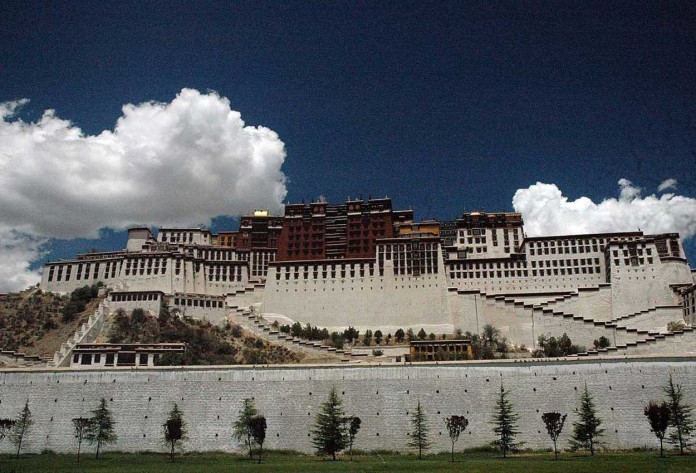NYINGCHI, China – China has unveiled a sparkling new hotel as part of its drive to get tens of millions more tourists to visit Tibet, even as critics say the push is slowly eroding the local culture.
With a presidential suite that costs US$1,000 (S$1,368) a night and views over the snow-capped mountains of the Himalayas, the luxury Artel hotel is a potent symbol of Chinese plans for the autonomous territory.
Tourism officials are hoping to see visitor numbers increase by nearly 50 percent in the next four years, said Wang Songping, deputy director of the Tibet Tourism Development Commission.
“Tibet attracted four million Chinese tourists in 2005. We hope we’ll get 24 million this year and 35 million by 2020,” he said.
Critics say the influx will lead to more of China’s dominant Han ethnic group settling in Tibet and eroding native Tibetan ways of life, and argue the majority of economic benefits of mass tourism will not go to locals.
Official figures say that Tibetans currently make up 90 percent of the local population, but groups opposed to Chinese rule say the real figure is significantly lower.
Beijing says it “peacefully liberated” Tibet in 1951 and insists it has brought development to a previously backward region where serfs were exploited.
But many Tibetans accuse Beijing of repressing their religion, diluting their culture and exploiting natural resources to benefit the Han at the expense of locals and the environment.
The 103-room Artel opened in mid-August in Lulang, a picturesque village situated at 3,700 metres (12,100 feet) in a southeastern forested area in the autonomous region of Tibet.
It is part of a tourist complex built in an old part of town previously occupied mostly by government buildings and restaurants, that now boasts its own shopping street, a lake and an arts centre.
Nicknamed the “Switzerland of the East”, the village is seen by authorities as a flagship project for its ambitious plans for Tibet’s tourist sector.
Transport links are being developed to cater for the influx, including a motorway opening next year, and a high-speed rail line from the capital Lhasa, expected to open in 2021.
Another high-speed rail line to Chengdu, capital of neighbouring Sichuan province, home to more than 80 million people, should be completed in 2022.
Wang said the number of Chinese tourists, who currently make up 95 percent of visitors to Tibet, has increased by an average of 20 percent each year since the 2006 opening of the first railway linking Tibet to the rest of China.
But while outside visitors can boost the local economy, mass tourism has down sides, said Tibet expert Francoise Robin.
“Cultural performances shown to visitors are either favourable reinterpretations of Chinese history or Chinese versions of songs or dances,” she said.
“Tibetans themselves end up picking up these distorted versions.” And while some Tibetans were developing responsible tourism initiatives and eco-tourism, such businesses could often not be developed on a large scale, she said.
The influx of tourists is expected to bring in billions of dollars but many are concerned that not everyone will benefit from the windfall.
“Travel agents and other people who work in the tourism industry are mostly Han Chinese”, said Robin. “The Tibetans… are among the last in line to benefit.” At the Artel hotel, Baima Cicuo, a 17-year-old local trainee who works as a housekeeper, said she was happy in her job – at least in front of her boss.
“Before, I depended on my farmer parents. But now I earn 1,000 yuan a month and I learn a lot of things,” she said in fluent Mandarin.
The hotel, owned by Poly, a Chinese state-owned group, has invested 280 million yuan ($42 million) in the project, says commercial director Ray Peng.
It currently has 40 employees, 15 of whom are Tibetan.
Its guests are likely to be overwhelmingly Chinese. Less than five percent of visitors to Tibet are foreign tourists, who need to obtain an “entry letter” as well as a Chinese visa when travelling to the region, where they must join an authorised tour group.
Despite the widespread perception that the restrictions are meant to stop the outside world from learning too much about the tensions between ethnic Tibetans and Han, officials insist that is not the case.
“These restrictions are in place because we can’t yet provide world class services for tourists”, said Bianba Zhaxi, deputy governor of Tibet.
“We will be open to tourists from across the world in a few years,” he added.
But Acharya Yeshi Phuntsok, deputy speaker of Tibet’s parliament in exile, said the restrictions serve to hide the truth about Tibet from the outside world.
“If foreign tourists and media are able to travel freely in Tibet, without organised tours, and can collect the views of people, then I think tourism can have a good impact.
“Otherwise, nobody will speak and share the problems of the Tibetan people.”






